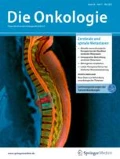Zusammenfassung
Die Rehabilitation nach Prostatakarzinom setzt Rehabilitationsbedürftigkeit und Rehabilitationsfähigkeit voraus. Ziel der Rehabilitation ist eine Besserung der gesundheitsbezogenen Lebensqualität durch rehabilitationsspezifische Therapiemaßnahmen. Nach Definition von Rehabilitationszielen wird ein Assessment von Funktionsstörungen durchgeführt. Der Erfolg der Rehabilitation misst sich am Verlauf der Evaluationsparatmeter, an der Wiedereingliederung ins Berufsleben oder der Verhinderung von Pflegebedürftigkeit. Nach Prostatektomie sollte eine Anschlussheilbehandlung durchgeführt werden, um eine rasche Besserung der Harninkontinenz durch ein ganzheitliches Kontinenztraining zu erreichen. Rehabilitation nach Prostatakarzinom sollte nur von qualifizierten onkologischen Rehabilitationskliniken durchgeführt werden, die über ein Qualitätsmanagementsystem verfügen und sich am Qualitätssicherungsprogramm der Rentenversicherungsträger beteiligen.
Abstract
Preconditions for the rehabilitation of prostate cancer patients are personal rehabilitation needs and rehabilitative ability. The aim of rehabilitation is to improve health-related quality of life by means of rehabilitation specific interventions. Defining the functional goals of rehabilitation is followed by functional assessment. To measure the success of rehabilitation, the outcome of functional measures, occupational reintegration, and prevention of the requirement for nursing care are evaluated. Following radical prostatectomy, an immediate rehabilitation program can quickly improve urinary incontinence by means of holistic continence training. Rehabilitation following prostate cancer should only be applied in qualified oncological hospitals or institutions with an integrated quality management system participating in the quality assurance programs of the public health insurance or pension insurance organizations.
Literatur
Augustin H, Pummer K, Daghofer F, Habermann H, Primus G, Hubener G (2002) Patient self-reporting questionnaire on urological morbidity and bother after radical retropubic prostatectomy. Europ Urology 42: 112–117
Baxter NN, Tepper JE, Durham SB et al. (2005) Increased risk of rectal cancer after prostate radiation: a population based study. Gastroenterology 128: 819–824
Bertetto O, Bracarda S, Tamburini M, Cortesi E (2001) Quality of life studies and genito-urinary tumors. Ann Oncol 12 [Suppl 3]: 43–48
Brock G, Nehra A, Lipshultz LI et al. (2003) Safety and efficacy of vardenafil for the treatment of men with erectile dysfunction after radical retropubic prostatectomy. J Urology 170: 1278–1283
Brüggeman S, Klosterhuis M (2005) Leitlinien für die medizinische Rehabilitation – eine wesentliche Erweiterung der Qualitätssicherung. RV aktuell 10/11: 467–475
Bundesarbeitsgemeinschft für Rehabilitation: Rahmenempfehlungen zur ambulanten onkologischen Rehabilitation, Schriftenreihe der Bundesarbeitsgemeinschaft für Rehabilitation, Frankfurt 2004
Chan JM, Gann PH, Giovannucci EL (2005) Role of diet in prostate cancer development and progression JCO 23: 8152–8160
Cooperberg MR, Lubeck DP, Meng MV et al. (2004) The changing face of low-risk prostate cancer: trends in clinical presentation and primary management. J Clin Oncol 22: 2141–2149
Dombo O, Otto U (2004) Lebensqualität nach radikalchirurgischen urologischen Eingriffen im Becken und die Bedeutung der Rehabilitation. Urologe A 44: 11–28
Gontero P, Fontana F, Bagnasacco A et al. (2003) Is there an optimal time for intracavernous prostaglandin E1 rehabilitation following nonnerve sparing radical prostatectomy? Results from a hemodynamic prospective study. J Urology 169: 2166–2169
Haaf HG (2005) Ergebnisse zur Wirksamkeit der Rehabilitation. Rehabilitation 44: 259–276
Harris M J (2003) Radical perineal prostatectomy: cost efficient, outcome effective, minimally invasive prostate cancer management. Europ Urology 44: 303–308
Heim ME, Kunert S, Özkan I (2001) Effects of inpatient rehabilitation on health-related quality of life in breast cancer. Onkologie 24: 268–272
Jo Y, Junichi H, Tomohiro F, Yoshinari I, Masato F (2005) Radical prostatectomy versus high-dose rate brachytherapy for prostate cancer: effects on health-related quality of life. BJU Int 96: 43–47
Kliesch S, Behre HM, Roth S (1997) Rationale Therapie der Hitzewallungen unter Hormonentzugsbehandlung bei Patienten mit fortgeschrittenem Prostatakarzinom. Dtsch Med Wochenschr 122: 940–945
Litwin MS, Sadetsky N, Pasta DJ, Lubeck DP (2004) Bowel function and bother after treatment for early stage prostate cancer: a longitudinal quality of life analysis from CaPSURE. J Urol 172: 515–519
Loblaw DA, Mendelson DS, Talcott JA, Virgo KS, Somerfield MR, Ben-Josef E, Middelton R, Posterfield H, Sharp SA, Smith TJ, Talpin ME, Vogelzang NJ, Wade JL, Bennet CL, Scher HI (2004) American Society of Clinical Oncology Recommendations for the Initial Hormonal Management of Androgen-Sensitive Metastatic, Recurrent, or Progressive Prostate Cancer. J Clin Oncol 22: 2927–2941
Madalinska JB, Essink-Bot ML, de Koning J, Kirkels WJ, van der Maas PJ, Schröder FH (2001) Health related quality-of-life-effects of radical prostatectomy and primary radiotherapy for screen-detected or clinically diagnosed localized prostate cancer. J Clin Oncol 19: 1619–1628
Montorsi F, Briganti A, Salvenia A, Rigatti P, Burnett AL (2004) Current and future strategies for preventing and managing erectile dysfunction following radical prostatectomy. Europ Urology 45: 123–133
Montorsi F, Nathan HP, MC Cullough et al. (2004) Tadalafil in the treatment of erectile dysfunction following bilateral nerve sparing radical retropubic prostatectomy: a randomized, double-blind, placebo controlled trial. J Urology 172: 1036–1041
Moul JW, Anderson J, Penson DF, Klotz LH, Soloway MS, Schulman CC (2003) Early Prostate Cancer: Prevention, Treatment Modalities, and Quality of Life Issues. Europ Urology 44: 283–293
National Comprehensive Cancer Network: Clinical Practice Guidelines in Oncology: Prostate Cancer Version 2. 2005. http://www.nccn.org
Potosky AL, Legler J, Albertsen PC, Stanford JL, Gilliland FD, Hamilton AS, Elay JW, Stephenson RA, Harlan LC (2000) Health outcomes after prostatectomy or radiotherapy for prostate cancer: results from the prostate cancer outcomes study. J Natl Cancer Inst 92: 1582–1592
Robert Koch Institut: Krebs in Deutschland, Häufigkeiten und Trends, 4. Auflage, Saarbrücken, 2004
Van Kampen M, de Weerdt W, van Poppel H, De Ridder D, Feys H, Baert L (2000) Effect of pelvic-floor reeduction on duration and degree of incontinence after radical prostatectomy: a randomized controlled trial. Lancet 355: 98–102
Young MD, Weizer AZ, Silverstein AD, Crisci A, Albala DM, Vieweg J, Paulson DF, Dahm P (2003) Urinary continence and quality of life in the first year after radical perineal prostatectomy. J Urol 170: 2374–2378
Interessenkonflikt
Es besteht kein Interessenkonflikt. Der korrespondierende Autor versichert, dass keine Verbindungen mit einer Firma, deren Produkt in dem Artikel genannt ist, oder einer Firma, die ein Konkurrenzprodukt vertreibt, bestehen. Die Präsentation des Themas ist unabhängig und die Darstellung der Inhalte produktneutral.
Author information
Authors and Affiliations
Corresponding author
Rights and permissions
About this article
Cite this article
Heim, M.E., Schwerte, U. Rehabilitation bei Patienten mit Prostatakarzinom. Onkologe 12, 434–443 (2006). https://doi.org/10.1007/s00761-006-1043-5
Issue Date:
DOI: https://doi.org/10.1007/s00761-006-1043-5

